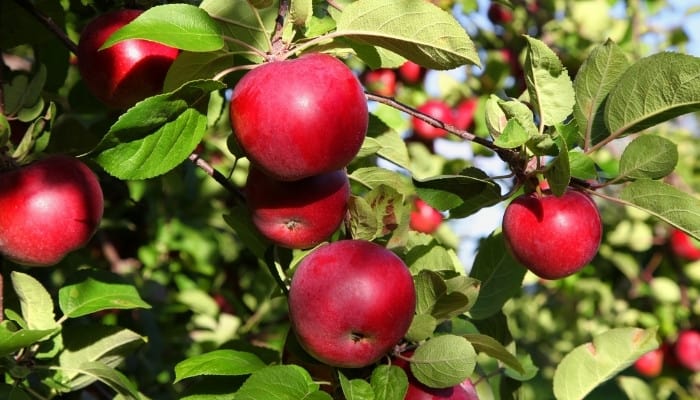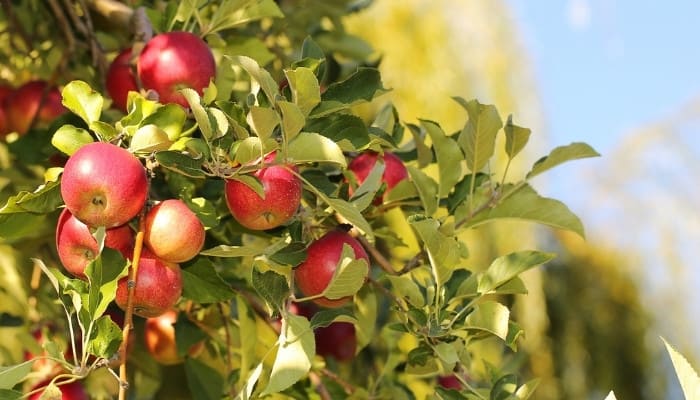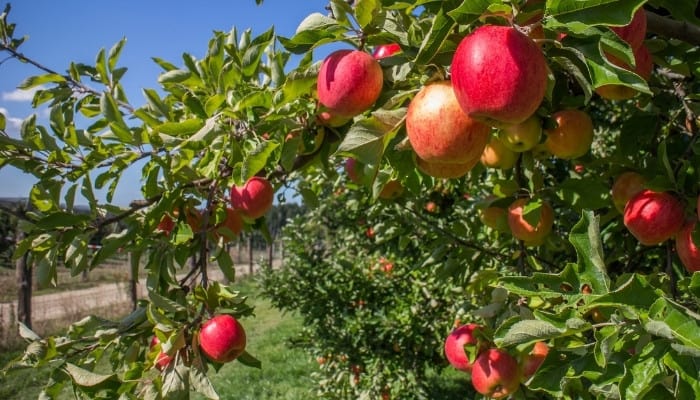Why not embrace the natural attraction of deer to apple trees and consider planting a diverse selection in your yard instead of trying to resist their presence?
But how do you even know what kind of apple you’ll prefer or what you can plant in your local hardiness zone?
Let’s answer this and more by looking at 15 apple trees you’re sure to fawn over (sorry)…
1. Liberty Apple Tree
Liberty varieties bear medium to large fruit in 3-4 years with a rosy-red coloring and sweet, subtly tart flavor.
This low-maintenance tree is among the most disease-resistant ever produced, lowering the need for fungicide sprays. Cold storage maintains its juicy, firm flesh.
- Ripens: September
- Best for Grow Zones: 4-8
- Average size: 20-25 feet
- Dwarf varieties available: Yes
- Insect and disease resistance: Apple scab, cedar apple rust, fire blight
2. Freedom Apple Tree
This grafted apple variety produces large, crisp fruit after 2-3 years with bright-red coloring and a yellow halo.
The taste is bold and moderately sour – making them perfect for cider and fresh eating. It’s also an excellent pollinator, especially to Liberty varieties.
- Ripens: Mid September
- Best for Grow Zones: 4-7
- Average size: 12-16 feet
- Dwarf varieties available: Yes
- Insect and disease resistance: Mildew, fire blight, apple scab
3. Enterprise Apple Tree
This is a super genetic mix of McIntosh, Golden Delicious, and Crabapple varieties lending it robust disease resistance, thick-skinned fruit, and exceptional quality after storage.
It bears glossy red fruit in 2-5 years with spicy flavoring that complements cinnamon in cooking.
- Ripens: October
- Best for Grow Zones: 4-7
- Average size: 10-15 feet
- Dwarf varieties available: Yes
- Insect and disease resistance: Apple scab, fire blight, mildew, cedar apple rust
4. Gold Rush Apple Tree
Gold rush is a winter-hardy dessert variety with great disease resistance.
In 2-4 years, they’ll produce large, crisp fruit with yellow, red-blushed skin and a tangy flavor upon harvesting before developing a golden hue and sweeter, mellow taste in storage.
- Ripens: October to mid November
- Best for Grow Zones: 4-10
- Average size: 10-12 feet
- Dwarf varieties available: Yes
- Insect and disease resistance: Powdery mildew, apple scab, fire blight
5. Yates Apple Tree
The Yates variety is a great pollinator for most other apple trees and bears small but attractive firm fruit in 2-5 years with pale red dotted/striped skin with yellowy undertones.
Its fragrant, juicy flesh makes it ideal for cider, apple sauce, and baking.
- Ripens: October
- Best for Grow Zones: 4-8
- Average size: 20 feet +
- Dwarf varieties available: No
- Insect and disease resistance: Apple scab, cedar apple rust, fire blight
6. Red Delicious Apple Tree

Red Delicious is a well-liked dark-red dessert apple with a crisp texture and great shelf life after harvesting. Despite the name, the flavor is very mild and akin to overripe melon.
This bears fruit in 3-10 years depending on dwarf or standard varieties.
- Ripens: End of September
- Best for Grow Zones: 5-8
- Average size: 20-25 feet
- Dwarf varieties available: Yes
- Insect and disease resistance: Apple scab, fire blight, mildew (moderate)
7. McIntosh Apple Tree

McIntosh varieties bear fruit in 2-10 years depending on the rootstock and require the pollination of trees with the same bloom duration, such as Fuji or Gala.
This produces large deep-red fruit with a greenish-yellow blush and its sweet-tart taste favors snacking not baking.
- Ripens: September
- Best for Grow Zones: 4-8
- Average size: 12-15 feet
- Dwarf varieties available: Yes
- Insect and disease resistance: Cedar apple rust, mildew
8. Ginger Gold Apple Tree
This early-ripening variety is heat tolerant and resistant to browning, helping it maintain its pleasant pale gold hue long after harvest.
Within 3-4 years, Ginger Gold bears medium-large conical-shaped fruit with a spicy flavor and honey-like aftertaste, making it enjoyable raw or cooked.
- Ripens: Mid-late August
- Best for Grow Zones: 5-8
- Average size: 12-15 feet
- Dwarf varieties available: Yes
- Insect and disease resistance: Apple scab only
9. Golden Delicious Apple Tree

This variety is a universal favorite producing mild and slightly sweet medium-sized fruit after 4-10 years with pale green-yellow dotted skin.
It requires the pollination of similar bloom period trees, such as Red Delicious or Falstaff, for better yields and is suited to fresh snacking or cooking.
- Ripens: End of September through early October
- Best for Grow Zones: 4-9
- Average size: 10-15 feet
- Dwarf varieties available: Yes
- Insect and disease resistance: Low resistance to apple scab and cedar apple rust
10. Rome Apple Tree

Within 2-3 years, this ruby red-skinned variety produces baking apples with juicy, mild flavoring.
Improve fruit production by planting pollinator partners, like Honeycrisp or Empire trees, nearby and prune heavily for improved health.
- Ripens: Late September
- Best for Grow Zones: 4-9
- Average size: 8-20 feet
- Dwarf varieties available: Yes
- Insect and disease resistance: Highly susceptible to most major apple blights
11. Arkansas Black Apple Tree
Within 2-5 years, this unique variety produces medium-large fruit with thick, dark, wine-colored skin that turns nearly black in storage.
Its firm, juicy flesh makes it suited for cooking and hard cider, but it is too tart and tough for snacking. Fruit size and quality improve with maturity.
- Ripens: October-November
- Best for Grow Zones: 4-8
- Average size: 15-20 feet
- Dwarf varieties available: No
- Insect and disease resistance: High-resistance to cedar apple rust
12. Jonathan Apple Tree

Jonathan trees typically bear fruit in 6-10 years, producing medium-sized maroon-red apples with a yellow base.
It has a crisp texture with a taste that is mostly sweet with an underlying spirituous quality. It also enjoys a long shelf life and is perfect for freezing, snacking, and cooking.
- Ripens: Late October through early November
- Best for Grow Zones: 4-8
- Average size: 15-25 feet
- Dwarf varieties available: Yes
- Insect and disease resistance: Apple scab, fire blight, cedar apple rust
13. Gala Apple Tree

This low-maintenance cultivar produces medium yellow and pinkish-red, heart-shaped fruit within 4-8 years. Its crisp, sweet flavor translates well to sauces, baking, or raw eating.
Yields are best when cross-pollinated with blossom buddies like Braeburn and Fuji.
- Ripens: Early October
- Best for Grow Zones: 4-9
- Average size: 8-15 feet
- Dwarf varieties available: Yes
- Insect and disease resistance: Highly susceptible to apple scab and fire blight
14. Dolgo Crabapple Tree
This incredibly cold-hardy variety produces small, olive-shaped apples (1-1.5 inches in diameter) in 2-5 years with bright-red skin which bleeds into the flesh, giving sauces and jellies a rosy hue.
These are also excellent pollinators due to an extended blooming period.
- Ripens: Mid-late September
- Best for Grow Zones: 2-9
- Average size: 16-20 feet
- Dwarf varieties available: Yes
- Insect and disease resistance: Fire blight, cedar apple rust, mildew
15. Chestnut Crabapple Tree
A great winter-hardy variety, Chestnut crabapple bears smallish bronze-red and yellow dotted dessert apples within 2-5 years.
The fruit is celebrated for its nutty, caramel-like flavor, making them perfect for cider, baking, or fresh snacking.
- Ripens: Early September
- Best for Grow Zones: 3-8
- Average size: 16-18 feet
- Dwarf varieties available: No
- Insect and disease resistance: Highly resistant to fire blight
Apple Trees for Deer: Planting Guide
Have the best success with your chosen variety by planting them in the right area and providing the care needed to flourish through the years.
When To Plant Apple Trees
Plant in late winter in mild climates or early spring in central/northern areas. Ensure the ground is thawed and not excessively wet.
Location & Spacing
Choose a full sunlight spot (6-8 hours of daily direct sun), avoid planting near woods or streams, and opt for higher ground where possible to prevent low-lying frost and poor air circulation killing blossoms.
Dwarf/semi-dwarf varieties need 8-15 feet of space while standard-sized trees require 30-35 feet.
Soil Preparation & Planting
Perform a soil test before planting to meet the recommended 5.5-7.0 pH and adjust accordingly.
I personally recommend this pH monitor as it also measures light levels and soil moisture – very handy!
Ideal soil is well-draining and sandy/loamy. Heavy clay mediums risk root rot.
Dig a hole at least double the diameter of the root ball and roughly 2 feet deep. When covering soil back over the roots, tamp down evenly and firmly to eliminate air pockets.
Provide support for dwarf varieties with fences or free-standing trellises.
Watering & Fertilization
Provide 1-2 inches of water weekly, and check top 3 inches of soil for moisture. After the first growing season, water only during extended periods of drought.
Once the tree has been established, apply specialized fruit tree fertilizer – use organic products whenever possible – this organic fruit/citrus food is perfect.
Maintenance
Remove dead/broken branches to increase airflow and light exposure, and maintain ideal soil pH to prevent relying on fertilizers to deliver nutrients.
Tips & Considerations for Selecting Apple Tree Varieties
- Choose highly disease-resistant varieties to avoid pesticide use.
- Apple trees generally have a soft pyramidal shape, though some varieties appear more oval or pointed, so consider this for height/spacing.
- Visit tree nurseries and field questions to specialist growers rather than picking a garden center variety.
- Dwarf-bush, spindle bush, and stepover varieties are ideal for smaller gardens.
- Decide whether you’ll be growing the apples for cooking, fresh eating, or storage.
Conclusion
Deer happily gobble up most apple types, but it may make sense to plant fall varieties like McIntosh or Golden/Red Delicious since these bear fruit throughout the deer hunting season.
Of course, don’t forget to consider how you’ll use the apples upon harvesting and the size and suitability of your planting site/grow zone.

